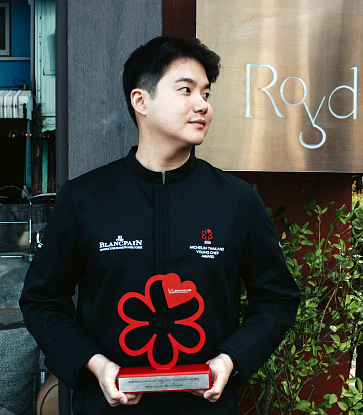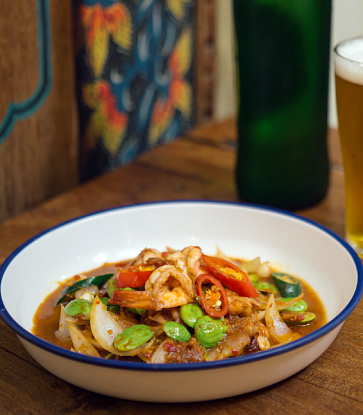When Chef Chalee Kader of MICHELIN Bib Gourmand recipient 100 Mahaseth presents an array of beef flank, sliced thin, and served raw, decorated with flowers and little strips of beef liver, it seems like something you could see in any city in the world – an elegantly prepared tartare. But then he gestures to the sauce. “This is the cow bile,” he says with a smile.
From that moment, it becomes apparent that in a city with thousands of Isan restaurants, 100 Mahaseth is something unique. For the past three years, in a cozy space at (shockingly) 100 Mahaseth Road, and more recently at their new Ekamai branch, Chef Kader and 100 Mahaseth have been reinterpreting the ethos of nose-to-tail – one of the major food trends of the past decade – in the context of Northeastern and Northern Thai food.
When asked what his concept is, he answers bluntly and knowingly: “It's Thai food, using brain to balls.”

A quick scan of the menu reveals items not for the faint of heart, with a special attention to offal transformed by the 100 Mahaseth team into something sublime. Hearts, tripe, blood, intestines, tails, bones, skin... things the diner might hesitate to order are made into gorgeously plated, crafted menu items that speak volumes about locality, in addition to being delicious.
After all, Chef Kader is quick to emphasise that for the natives of this region, “nose to tail” is hardly just a trend. Speaking about the villages of the Northeast where he gets his inspiration, he points out that “they have so many methods to preserve things, to make sure the whole pig is being used, maybe a month from now. And they have to plan it really well... We want to take all that methodology, all that knowledge, to use in our cooking.” For the farmers across the Northeast from whom Chef Kader sources his ingredients, the cuts he's using are part of their daily life. “It's only strange when we bring it into Bangkok, and the Bangkokians frown.”
It is this reflection of local foodways that separates 100 Mahaseth from so many other restaurants around the world that have tried to jump on the bandwagon. “Maybe seven to eight years ago, there was a lot of hype about nose-to-tail, and it's quite disappointing when you go there and there's only pate and braised tongue. Come on now. Once you get into the adventurous cuts and offal, then you're actually making a statement, and the place has a certain persona to it, and people come in with a mindset ready to be adventurous about it.”

With the focus on local wisdom and using unusual cuts, it is not surprising that sustainability and zero-waste principles also factor in. When one goes to the supermarket and looks at the cuts of pork and beef that are available, the selection is usually quite limited – there are rows and rows of prime cuts like pork loin and ribeye, as well as lesser cuts turned into ground meat. So what happens to the rest of the animal? Where does everything else go?
The answer, regrettably, is that most of it gets incinerated, or at best processed for more industrial uses. A recent study in Germany stated that livestock emissions could be reduced by up to 14 percent by the public adopting a diet higher in offal and organ meats.
Chef Kader sees this as an opportunity for creativity. “When we first started this, our ethos was to use every part of the cow. If we're going to drop a cow or a pig, we try to use every single part of it... We can't just call them and say we want the meaty ribs, we want the tenderloin. We can't play that game. There's a lot of offal there that's good quality. Why don't we explore that and use it?”
Despite the economic and environmental logic of this perspective, and despite the dizzying variety of flavours and textures that can be discovered, this can be a real challenge from a marketing perspective. When customers spend their hard-earned money on a meal out, they are far more likely to choose something familiar and comforting – whether a streetside plate of khao man kai or a nicely grilled sirloin – than to take their chances on a skewer of duck hearts.

This might be especially true in Bangkok, a city with a notoriously fickle dining public. Chef Kader laughs and admits, “The only reason I didn't want to open a Thai restaurant is because if I had to feed 10 Thai people, I'd get 10 complaints.” Not only are local diners quite discerning, he notes that there is also a certain conservatism in the way that Isan food in particular is treated. Streetside venues usually have extremely similar menus, and more upscale venues, primarily in shopping malls, also tend to stick to the classics. So how does he deal with this?
“We try to keep it as close to something relatable as possible. We take a menu item and try to make it ours, or do it in a way that elevates whatever's available on the street.” And his menu items reflect that mission, whether through a kaeng khee lek (a curry made with bitter cassia leaves) featuring unctuous oxtails and thickened with dried buffalo skin, topped with a refreshing salsa. Or som tam served as it is in the former Lao royal capital of Luang Prabang, with wide ribbons of papaya rather than the familiar thin slivers and a healthy dose of funky pla ra, or a marrow bone topped with perilla seeds and served in dramatic style.
So on the next meal out, maybe forgo the familiar filet mignon. There is a small restaurant in a former parking garage on Mahaseth Road, a little off Charoen Krung, where kidneys or hearts take centre stage. Give these oft-neglected cuts a try – they might manage to surprise and delight.

Here’s What Our Inspectors Said About 100 Mahaseth (Bib Gourmand)
Specialising in ‘nose to tail’ eating inspired by Indochina flavours, the ingredients here are sourced directly from the farm. Favourites include creamy bone marrow with flavoursome Thai-style sauce, as well as the robustly spiced northern hotdog, which has a real kick. Interiors are rustic and industrial with a hint of Thai countryside, while the dry-ageing meat cabinet adds a modern element. A tasting menu is available if ordered in advance.
Hero photo: © Watsamon Tri-yasakda/ MICHELIN Guide Thailand


















